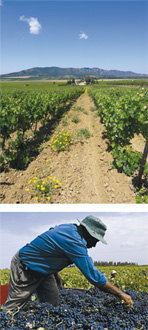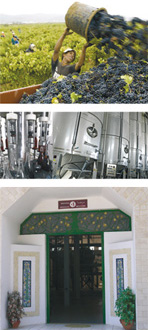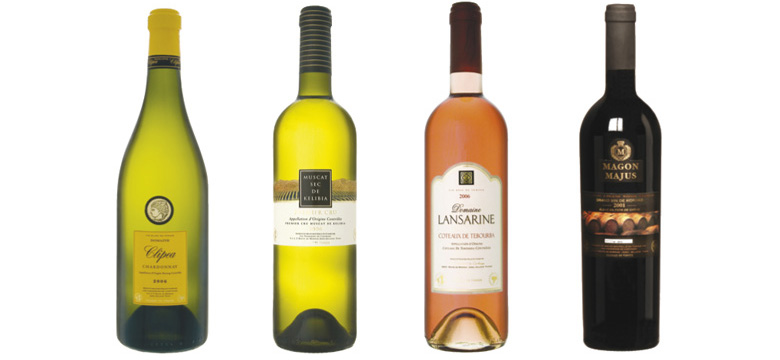World Tunisia
Tunisian wines:
the start of a new era in an Old World
Wine globalisation is moving at full speed. Everyone wants his share of markets worldwide. After Morocco, and as we await Algeria, Tunisia is now pulling out all the stops to re-establish its ertswhile booming wine industry.
The smart suburbs of Tunis… in the area near the Saint-Louis Cathedral, a rather rococo construction, but a pure treasure of Roman-Byzantine style of the end of the 19th century, it is one of the vestiges of the Phoenician and then Roman era of ancient Carthage, where the eminent strategist Hannibal was born. From here, one can cast an eye out to the Mediterranean, a scene that witnessed long years of rivalry between Rome and Carthage. So close to Europe, it is almost possible to pick out the coast of Sicily on some days, and yet so closely linked to Africa, but forasmuch never far removed from the East, the magnificent Bay of Tunis is a perfect place for daydreams. Between wars, pillages and various conquests, it is easy to imagine the intense maritime traffic which must have animated this bay, the birthplace of wine civilisation. Excellent navigators and skilled tradesmen, the founders of Carthage certainly contributed to propagating vines and olive trees around the shoreline of the Mediterranean. Several centuries before Jesus-Christ, a man named Magon, born in Carthage, became famous for writing an agronomy treatise partly dedicated to vine growing. In his native land of Tunisia, a wine now bears his name. In the mountains, mainly upon the hillsides of Cap Bon, between olive and orange groves, an ancestral winegrowing area is emerging from a deep slumber and proving itself ready, like a new version of Hannibal, to conquer the third millennium.
On the subject of Tunisian wines, is it right to classify them as New World wines?
Certainly not: especially when we consider that many years after the Carthaginians, who were the first winegrowers here, the French made Tunisia one of the leading wine-producing countries, following closely behind Algeria and Morocco, with a strike force of 7 AOCs, which still maintain a place of honour on labels. At the time of the “Protectorate”, between the 19th and 20th centuries, phylloxera caused havoc in France. Whilst northern vineyards were gradually eaten away by these nasty aphids, Maghreb colonists were the first to take advantage and gain wealth from this situation, taking example from producers in the Languedoc area. They transported their wines to the port of Sète for the delight of a huge number of French consumers and Midi wine merchants, who for many years used these “curative” wines to smooth out the angles (degrees of alcohol and colour) of most of our French wines. But supply also needed to be provided for the local population comprised of real wine drinkers, such as soldiers, civil servants of the Colonial Army, and a large majority French and Italian colonist workers and labourers. Between 1936 and 1947, in the region of Cap Bon, which represents 80% of the Tunisian winegrowing area, and also in Algeria and Morocco, vines were in turn attacked by phylloxera. Faced with this crisis, growers joined forces by creating cooperatives and attempted to re-establish the winegrowing area and in fact set out the initial contours of current AOCs. After the Second World War, this is how a union of cooperatives became known as ‘Les Vignerons de Carthage’. 60 years after its creation, more than 50 years after Independence and 40 years after the nationalisation of colonial lands, following a gradual abandon of vineyards, ‘Les Vignerons de Carthage’, also known as the ‘Union Centrale des Coopératives Viticoles’, succeeded in establishing their position. The Union is still comprised of 10 cooperative cellars, of which 6 are able to ensure modern (safe), wine-making procedures.

The Tunisian winegrowing area is still quite small: in total it covers approximately 15 000 hectares. With an annual production of 30 million bottles of Tunisian wine, more than 20 million are made by cellars that belong to ‘Les Vignerons de Carthage’. “About 70% of our production is sold in Tunisia” remarks Belgacem D’Khili, an oenologist who qualified in Bordeaux. He is comfortably settled in his office in Tunis, where he supervises the production of his 1 500 winegrowers, who represent a total cultivation area of 9 000 hectares. “Don’t be mistaken in thinking that millions of tourists drink our wines. The tourist industry only represents a quarter of our wine sales.” In the opinion of the Managing Director of the UCCV, wine is an integral part of Tunisian culture. Naturally, 98% of Tunisians are Muslim and do not shout about this fact, but as true inhabitants of the Mediterranean, they like wine and even appreciate good wines. “We have kept the oldest Grenache Noir and Carignan vines” adds Belgacem D’Khili, who has worked for several years to ensure upgrading for cellars whose standards of hygiene could serve as an example for many European cooperative cellars. “With the financial aid of Tunisian and foreign investors, we have also made considerable efforts by planting the most up-to-date varieties such as Chardonnay, Syrah, Pinot Noir, Cabernet Sauvignon and Merlot. From the outset our aim has been to avoid producing bulk wine, as it really prevents the development of our wine production. Currently, we are not losing money. On the contrary, we are actually beginning to earn some. Our exports, to France and Germany especially, are constantly growing.”

Amongst the twenty or so wines from ‘Les Vignerons de Carthage’ tasted (rather quickly) when I visited the cellar, I can confirm the marvellous quality of at least half. This is the case of the excellent sparkling wine (‘méthode traditionnelle’, made with Chardonnay), produced in an underground cellar at Fontaine aux Mille Amphores, just north of Carthage, whose release date and name are still top secret! It is a delicate, lively, well-balanced wine, marked by lovely fruity flavours and it has lovely texture. Having savoured this wine throughout the evening, it did not leave me with any unpleasant memories the following day! The Muscat, ‘Passum de Magon’ 2007 (a fortified wine, with a screw cap) is absolutely wonderful: it has elegance, length on the palate, freshness and class. Its older brother, the dry Muscat ‘Kéliba’ 2006 is to be ranked amongst the fine specialities of Cap Bon, and classified as a “first growth”. This Muscat from Alexandria, with a production of nearly 200 000 bottles, is full-bodied, quite pure and well-balanced with delicate hints of citron. The white ‘Mornag’ 2007, ‘Domaine de Clipea’ (Chardonnay, 4 € a bottle at Carrefour – production 200 000 bottles) is pure, simple and straightforward. As for ‘Mornag’ 2001, ‘Vieux Magon’ (70% old Carignan, 30% Syrah), its aromas evoke hints of scrubland and it has delicate tannins on a classic backdrop of red fruits. You should note that ‘Mornag’, also available in rosé, is Tunisia’s largest wine appellation, with a total area of 6 000 hectares. The majority of these wines are distributed in France by the firm Laplace in Villeneuve-Saint-Georges (Telephone: 01 43 82 11 20). In particular, watch out for the new wines of ‘Domaine Reine d’Elissa’, named after the Phoenician founder of Carthage. Oenologist Pilar Rodrigo, a native of Valence in Spain who trained in Montpellier, enthusiastically follows the progress of this estate promised a magnificent future. In the meantime, Belgacem D’Khili intends to make France his leading export market. “At present we sell 80 000 bottles to France. Our aim is to reach a total of 500 000 in the near future!”
In view of what Belgacem D’Khili has achieved in Tunisia, we can but believe in his goal. Tunisia is in the process of resuming its rightful place amongst Old World wines. Michel Smith





